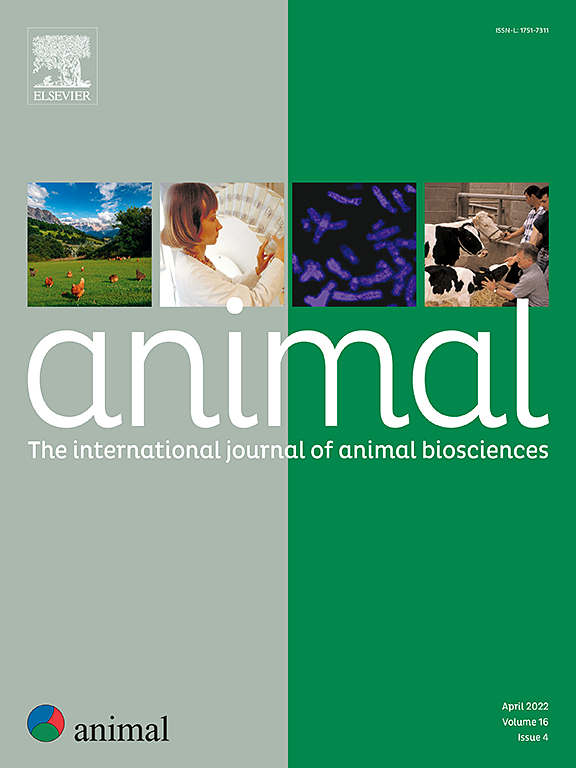The development of a tool to assess cow quality of life based on system-level attributes across pastoral dairy farms
IF 4
2区 农林科学
Q1 AGRICULTURE, DAIRY & ANIMAL SCIENCE
引用次数: 0
Abstract
Progress has been made in developing cow welfare assessment protocols that focus on the cow; however, system-level assessment has received less attention. This paper presents a process undertaken to develop a tool to identify opportunities and risks for cow quality of life at the system level across pastoral dairy farms and piloting the tool in New Zealand. The Farm System Welfare Assessment Tool incorporates elements from the Five Domains Model and is based on four domains (nutrition, health, physical environment, and behavioural interactions) and a fifth area ‘people’ with 21 system attributes captured under these areas that are assessed through on-farm visits. Overall, 222 farms were visited, and attributes were allocated a score based on the degree of risk posed to cow welfare at the system level. Results were summarised to provide an overall score for New Zealand dairy farm systems for each attribute within season. An attribute was defined as low risk when opportunities for neutral or positive experiences were provided, while negative experiences were minimised; moderate risk when some opportunities for neutral or positive experiences were provided, but negative experiences may still exist, and; high risk when opportunities for neutral or positive experiences were restricted and negative experiences exist. Overall, 85% of attributes (n = 66/78) across all seasons (19 attributes assessed across four seasons, plus one attribute which was only relevant in spring and one scored year-round) were classified as low risk, 10% were classified as moderate risk (n = 8/78) and 9% were classified as high risk (n = 7/78). From the 15 attributes that scored moderate or high risk, physical environment (40%; n = 6/15), people (27%; n = 4/15), and behavioural interactions (20%; n = 3/15) were the highest-risk areas followed by nutrition and health (both 7%; n = 1/15). Six attributes including health prevention, provision of quality feed, adequate space, good ventilation, natural lighting, and well-designed infrastructure were scored low risk across all seasons indicating neutral experiences are likely. Higher risk attributes with the potential to restrict opportunities for positive experiences included inadequate staffing, exploration and grooming during winter, and expression of maternal behaviour, while lower risk attributes with the possibility to provide opportunities for positive experiences included foraging, daily routine, and social contact. The tool was able to identify aspects of New Zealand farm systems that are likely to provide opportunities for neutral or positive experiences, where opportunities for positive experiences are restricted, and where negative experiences may occur. Future research could investigate the wider application of our approach within other dairy farm systems and countries.
开发一种基于牧区奶牛场系统级属性来评估奶牛生活质量的工具
在制定以奶牛为重点的奶牛福利评估协议方面取得了进展;然而,系统级评估受到的关注较少。本文介绍了开发一种工具的过程,该工具可以在整个畜牧奶牛场的系统层面上识别奶牛生活质量的机会和风险,并在新西兰试用该工具。农场系统福利评估工具结合了五领域模型的要素,基于四个领域(营养、健康、物理环境和行为相互作用)和第五个领域“人”,其中包括在这些领域下捕获的21个系统属性,通过农场访问进行评估。总共访问了222个农场,并根据对奶牛福利构成的风险程度在系统层面上对属性进行了评分。对结果进行总结,以提供新西兰奶牛场系统在季节内的每个属性的总体得分。当提供中性或积极体验的机会,而消极体验被最小化时,一个属性被定义为低风险;当提供了一些中性或积极体验的机会,但消极体验可能仍然存在时,风险为中等;当中性或积极体验的机会受到限制,而消极体验存在时,风险就会很高。总体而言,所有季节中85%的属性(n = 66/78)(4个季节评估19个属性,加上1个仅与春季相关的属性和1个全年评分)被划分为低风险,10%被划分为中度风险(n = 8/78), 9%被划分为高风险(n = 7/78)。在被评为中度或高风险的15个属性中,物理环境(40%;N = 6/15),人(27%;N = 4/15),行为相互作用(20%;N = 3/15)是风险最高的领域,其次是营养和健康(均为7%;n = 1/15)。包括预防健康、提供优质饲料、充足的空间、良好的通风、自然采光和精心设计的基础设施在内的六个属性在所有季节都被评为低风险,表明可能会有中性体验。有可能限制积极体验机会的较高风险属性包括人员配备不足、冬季探索和梳理以及母性行为的表达,而有可能提供积极体验机会的较低风险属性包括觅食、日常生活和社会接触。该工具能够识别新西兰农场系统中可能为中性或积极经验提供机会的方面,其中积极经验的机会受到限制,以及可能发生消极经验的方面。未来的研究可以调查我们的方法在其他奶牛场系统和国家的更广泛应用。
本文章由计算机程序翻译,如有差异,请以英文原文为准。
求助全文
约1分钟内获得全文
求助全文
来源期刊

Animal
农林科学-奶制品与动物科学
CiteScore
7.50
自引率
2.80%
发文量
246
审稿时长
3 months
期刊介绍:
Editorial board
animal attracts the best research in animal biology and animal systems from across the spectrum of the agricultural, biomedical, and environmental sciences. It is the central element in an exciting collaboration between the British Society of Animal Science (BSAS), Institut National de la Recherche Agronomique (INRA) and the European Federation of Animal Science (EAAP) and represents a merging of three scientific journals: Animal Science; Animal Research; Reproduction, Nutrition, Development. animal publishes original cutting-edge research, ''hot'' topics and horizon-scanning reviews on animal-related aspects of the life sciences at the molecular, cellular, organ, whole animal and production system levels. The main subject areas include: breeding and genetics; nutrition; physiology and functional biology of systems; behaviour, health and welfare; farming systems, environmental impact and climate change; product quality, human health and well-being. Animal models and papers dealing with the integration of research between these topics and their impact on the environment and people are particularly welcome.
 求助内容:
求助内容: 应助结果提醒方式:
应助结果提醒方式:


